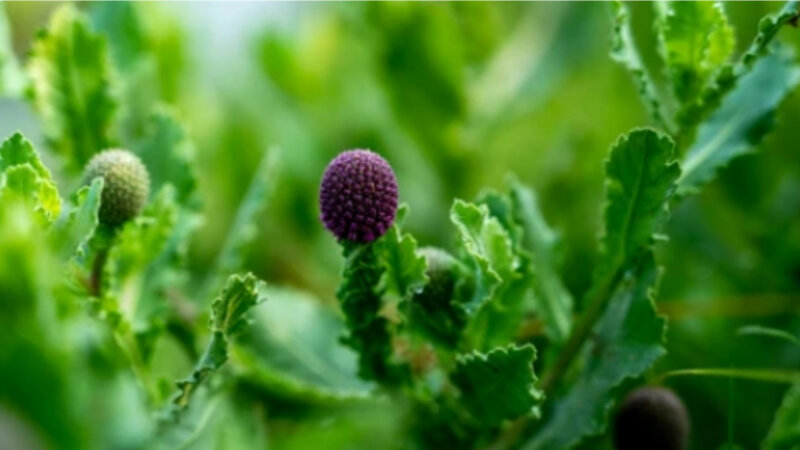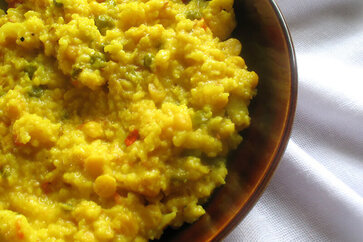Gorakhmundi Plant: Exploring The Health Benefits And Traditional Uses
Gorakhmundi, also known as Sphaeranthus indicus, is a medicinal plant that is native to India and other parts of Southeast Asia. It has been used in traditional Ayurvedic medicine for centuries due to its various health benefits.
The Gorakhmundi plant is a small, herbaceous annual or perennial plant that grows up to 30-60 cm in height. It has slender branches and produces small, yellow flowers with a spherical shape, which is why it is called Sphaeranthus, meaning “spherical flower.”
Different parts of the Gorakhmundi plant, including the leaves, flowers, and roots, are used for medicinal purposes. It contains various active compounds, such as flavonoids, alkaloids, tannins, and saponins, which contribute to its therapeutic properties.
How Does The Gorakhmundi Plant Look?
The Gorakhmundi plant has a prostrate or procumbent growth habit, meaning it spreads horizontally along the ground. It is characterized by a tomentose or villous texture, indicating that it has a hairy or fuzzy appearance. This annual herb is commonly found in areas with drying moist ground and can grow from normal land to elevations of up to 5,000 feet in the Himalayas.
The plant has spreading stems and branches that are glandular-hairy, meaning they have small glandular hairs on their surface. The stems are pink or purple in color. The leaves are toothed and have a wing-like structure. They are arranged alternately along the stem.
Gorakhmundi produces flowers that are terminal, meaning they grow at the ends of the stems. The flowers are arranged in globose (rounded) violet-colored heads, forming an inflorescence.
In terms of size, the plant typically reaches a height of 30-45 cm. The stems are winged, meaning they have thin extensions or ridges along their sides. The flower heads are approximately 0.6-2 cm in diameter and 0.5-1.5 cm in height. They have a globose or ovoid shape.
The fruit of the Gorakhmundi plant is an achene, which is a type of dry fruit that does not split open. The achenes are nearly 1 mm long and have an oblong or obconical shape. They are angled, subcompressed (slightly flattened), and almost glabrous (almost hairless).
Note: The description provided is based on the general characteristics of the Gorakhmundi plant, but variations in appearance can occur depending on factors such as environmental conditions and individual plant specimens.
Gorakhmundi Plant In Ayurveda
In Ayurveda, the Gorakhmundi plant holds significance despite not being classified under Charaka Dashemani2. However, it is recognized by Sushruta and Vagbhata and grouped under surasaadi gana3.
Various synonyms have been attributed to it, such as alambusha, kadmbapushpi, bhukadamba, and kulahala4, specifically referring to the head inflorescence of the plant.
In Ayurvedic medicine, the entire Gorakhmundi plant is utilized for its medicinal properties. It is considered to have tonic effects on the body, helping to strengthen and invigorate it.
Additionally, it is believed to possess deobstruent properties, helping to clear obstructions and promote normal bodily functions.
The plant is also regarded as an alternative, which means it may aid in purifying the blood and promoting overall health. Furthermore, Gorakhmundi is recognized as an aphrodisiac, believed to enhance sexual vigor and vitality.
Specifically, the flowers of the Gorakhmundi plant are recommended for certain purposes in Ayurveda. They are suggested as an alternative treatment option, offering potential benefits in replacing or supplementing conventional remedies.
The flowers are also considered cooling agents, providing a soothing and calming effect. Additionally, they are regarded as tonics, contributing to overall wellness and vitality.
Note: Gorakhmundi has a history of use in Ayurvedic medicine, individual experiences may vary, and it’s always advisable to consult with a qualified Ayurvedic practitioner or healthcare professional for personalized advice and appropriate dosage recommendations.
Synonyms
- English: East Indian Globe Thistle
- Sanskrit: mahamundi, Mundi, hapusa
- Hindi, Bengali, Marathi, Gujarathi: Mundi, gorakh Mundi
- Telugu: Boddatarupu, boddasoramu
- Tamil: kottakaranthai
- Malayalam: mirangani, adakkamaniyan
- Oriya: Murisa, buikadam, bokashungi
- Punjabi: ghundi, khamadrus; Santal
Ayurvedic Properties of Gorakhmundi
Gorakhmundi (Sphaeranthus indicus) has several Ayurvedic properties that contribute to its traditional medicinal use. Here are some key Ayurvedic properties associated with Gorakhmundi:
1. Rasa (Taste): Gorakhmundi is known to have a combination of pungent (katu), bitter (tikta), and sweet (madhura) tastes.
2. Virya (Potency): It is considered to have a hot (ushna) potency.
3. Vipaka (Post-Digestive Effect): Gorakhmundi is believed to have a pungent (katu) post-digestive effect.
4. Dosha Effects: It is known to pacify Kapha and Vata doshas, making it beneficial for balancing these energies in the body.
5. Guna (Qualities): Gorakhmundi is characterized by lightness (laghu) and dryness (ruksha) qualities.
6. Prabhava (Special Effect): Gorakhmundi is recognized for its nervine, diuretic, vermicide, and blood purifying properties.
7. Traditional Uses: In Ayurveda, Gorakhmundi is traditionally used for various purposes, including treating skin conditions, epilepsy, anemia, obesity, stomach diseases, dysuria, jaundice, cough, and as an aphrodisiac.
Note: It is important to note that these Ayurvedic properties are based on traditional knowledge and should be used as a general guide.
For personalized advice and specific treatment recommendations, it is recommended to consult with a qualified Ayurvedic practitioner or healthcare professional.
General Properties Of Gorakhmundi Plant
The Gorakhmundi plant, or Mundi, is characterized by its taste, post-digestive effect, potency, and its effects on the doshas (Kapha and Vata). It has a pungent, bitter, and sweet taste and a pungent post-digestive effect. In terms of potency, it is considered hot.
Mundi is known to alleviate Kapha and Vata doshas, the energies or forces in the body according to Ayurveda. It possesses light and dry attributes, contributing to its overall nature.
In Ayurvedic medicine, Mundi is recognized for its various properties. It is considered nervine, meaning it has a positive effect on the nervous system. It is also known as a diuretic, promoting urine production and helping in the elimination of toxins.
Additionally, Mundi is believed to have vermicide properties, which means it can help expel intestinal worms. Moreover, it is considered a blood purifier, aiding in the purification of the blood.
Mundi finds application in the treatment of various diseases. It is used in managing skin affections, addressing conditions related to filariasis (a parasitic disease), providing support for epilepsy, addressing anemia (low blood count), assisting in weight management for obesity, and treating diseases related to the anal and vaginal canal.
It’s important to note that while Mundi has been used in Ayurvedic medicine for these purposes, individual experiences may vary. It’s always recommended to consult with a qualified Ayurvedic practitioner or healthcare professional for personalized advice and appropriate usage recommendations based on your specific health condition.
Ayurvedic Formulations Based On Gorakhmundi Plant
It is used as an ingredient in some important Ayurvedic formulations like
- Shwadamshtradi ghrita
- Chandanaadi taila
- Amritaadi taila
- Parushaka ghirta
- Tritiyasarpi guda
Gorakhmundi Plant Uses
Gorakhmundi, with its entire plant and flowers, possesses significant medicinal value and finds diverse applications in traditional medicine. It is employed for various medicinal purposes, both internally and externally. Let’s explore the medicinal benefits and uses of Gorakhmundi:
1. Internal Use: The plant is utilized internally in different forms, such as decoctions, extracts, or powders, to address various health conditions. Some of its common internal uses include:
- Tonic: Gorakhmundi is valued as a tonic, promoting overall well-being and vitality.
- Blood Purifier: It is believed to have blood-purifying properties, assisting in the elimination of toxins from the body.
- Digestive Aid: Gorakhmundi is used to support digestion and relieve digestive discomfort.
- Anti-inflammatory: It is known for its anti-inflammatory properties and is used to reduce inflammation within the body.
- Diuretic: Gorakhmundi is used as a diuretic, promoting urine production and assisting in flushing out waste products.
2. External Use: The external application of Gorakhmundi is primarily focused on topical treatments for various conditions. Some common external uses include:
- Skin Affections: Gorakhmundi is employed in the treatment of skin conditions such as rashes, acne, and eczema.
- Wound Healing: It is used topically to aid in wound healing and promote skin regeneration.
- Cooling Agent: Gorakhmundi is known for its cooling properties, providing relief from heat-related skin conditions and soothing skin irritations.
- Hair Care: It is utilized in hair care preparations to nourish the scalp and promote healthy hair growth.
It’s important to note that the above uses are based on traditional knowledge and practices. While Gorakhmundi has a history of use in traditional medicine, individual experiences may vary.
It is advisable to consult with a qualified healthcare professional or traditional medicine practitioner for personalized advice and appropriate dosage recommendations based on specific health conditions.
Traditional Uses Of Gorakhmundi Plants
1. Hemorrhoids: The bark is crushed and mixed with whey for topical application to treat hemorrhoids. Internally, the bark powder is used to address this condition. Additionally, a paste made from the leaves, flowers, and seeds can be applied topically for hemorrhoid relief.
2. Fishing: The whole plant is employed as a fish poison for catching fish.
3. Crabicidal: Placing the entire plant in crab nests is believed to be effective in killing crabs.
4. Anthelmintic: The plant has anthelmintic properties. A paste made from the whole plant mixed with oil is used for this purpose. Roots and seeds are used as a stomachic and anthelmintic. Powdered roots and seeds are ingested to eliminate intestinal worms in children. A decoction of the leaves is taken on alternate days in the morning, eight times in total, as an anthelmintic.
5. Cough: A decoction of the root is used for chest pains, coughs, and bowel ailments. Boiled leaf juice mixed with milk is made into lozenges for cough relief.
6. Tonic: The flowers of Gorakhmundi are known for their cooling and tonic properties.
7. Stomach Disorders: The juice of the whole plant is considered to have a hemostatic effect and is used for liver and stomach diseases. Consuming a paste made from the inflorescence on an empty stomach is believed to help with excess bile.
8. Dysuria: Root paste combined with black pepper is taken twice a day to alleviate dysuria (painful or difficult urination).
9. Jaundice: Tribes use a decoction of the leaves to treat jaundice.
10. Mouth Ulcers: Chewing raw leaves or consuming leaf juice orally is believed to be beneficial for treating mouth ulcers and other oral cavity conditions.
11. Abdominal Pain: Wearing a root amulet is believed to provide relief from abdominal pain.
12. Leucorrhea: Taking one teaspoon of root powder with a glass of water twice a day for 30 days is suggested for treating leucorrhea.
13. Elephantiasis: A combination of leaf juice (5 ml), long pepper, and table salt is administered for ten days to address elephantiasis.
14. Swelling: Applying a paste made from the whole plant mixed with coconut oil helps reduce painful swelling.
15. Scabies: The juice of the leaves, when mixed with water, is used for bathing to alleviate symptoms of scabies.
16. Skin Conditions: Consuming powdered whole plant internally is believed to be effective against skin conditions. A paste made from the leaves, flowers, and seeds is applied topically for skin conditions.
Applying a paste made from the whole plant helps relieve skin irritation. Root paste mixed with the juice of tender pericarp of coconut or lemon is also used for skin ailments.
17. Diarrhea and Dysentery: A paste made from the flowers and leaves is administered on an empty stomach to treat dysentery, diarrhea, and indigestion. Leaf sap is used to address diarrhea and vomiting.
Consuming fresh leaves with caraway seeds helps with dysentery. In the case of dysentery in children, exposing them to the vapor of the whole plant is recommended.
18. Eye Infections: Soaking the inflorescence in water overnight and using the juice as eye drops or for eye cleansing helps treat eye infections.
19. Toothache: Chewing the stem and leaf is believed to provide relief from toothaches.
20. Blood Purifier: Consuming the juice of the inflorescences internally helps purify the blood and alleviate itching.
21. Earache: Instilling a mixture of leaf extract and black pepper powder into the ears is suggested for earaches.
22. Viral Hepatitis: Consuming 50 grams of powdered Gorakhmundi once a day with water is recommended for treating viral hepatitis.
23. Aphrodisiac: Drying the plant in the ghee stage and mixing it with Deshi ghee and honey is consumed orally for 38 days to enhance sexual strength.
The root powder mixed with hot Sesamum indicum (Til) oil is applied to the male genitals to achieve a strong erection. Consuming a juice made from a handful of leaves for three days is believed to help preserve pregnancy.
24. Rheumatic Pain: Cooking the leaf with rice and consuming it is believed to provide relief from rheumatic pains.
25. Scabies: Studies have shown that a decoction made from the entire plant significantly improves the signs and symptoms of scabies after 15 days of treatment.
Frequently Asked Questions on Gorakhmundi
Q1: What is Gorakhmundi?
A: Gorakhmundi (Sphaeranthus indicus) is a medicinal plant that is commonly used in traditional Ayurvedic medicine. It is an annual herb with pink or purple flowers and is known for its various therapeutic properties.
Q2: What are the traditional uses of Gorakhmundi?
A: Gorakhmundi has been traditionally used for treating a range of ailments. Some of its traditional uses include the treatment of piles, skin conditions, epilepsy, anemia, obesity, stomach diseases, dysuria, jaundice, cough, and as an aphrodisiac. It is also used as a blood purifier and for its diuretic and vermicide properties.
Q3: How is Gorakhmundi used medicinally?
A: Different parts of the Gorakhmundi plant, such as the leaves, flowers, roots, and seeds, are used for medicinal purposes. They can be consumed internally as decoctions, powders, or pastes, or applied externally as poultices or ointments, depending on the specific ailment being treated.
Q4: Is Gorakhmundi safe to use?
A: Gorakhmundi is generally considered safe for use when taken in appropriate doses and preparations. However, it is recommended to consult with a qualified Ayurvedic practitioner or healthcare professional before using Gorakhmundi, especially if you have any underlying health conditions or are taking medications, to ensure its safe and effective use.
Q5: Where can I find Gorakhmundi products?
A: Gorakhmundi products, such as dried herbs, powders, capsules, or oils, can be found in Ayurvedic or herbal stores, online retailers specializing in herbal products, and some health food stores. It is important to source Gorakhmundi products from reputable suppliers to ensure their quality and authenticity.
Q6: Can Gorakhmundi be grown at home?
A: Yes, Gorakhmundi can be grown at home, particularly in regions with a suitable climate. It is an annual herb that requires well-drained soil, moderate sunlight, and regular watering. Seeds or seedlings can be obtained from nurseries or online suppliers specializing in medicinal plants. Proper care and cultivation guidelines should be followed for successful growth.


























